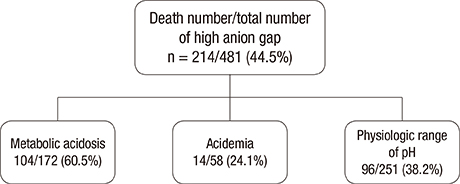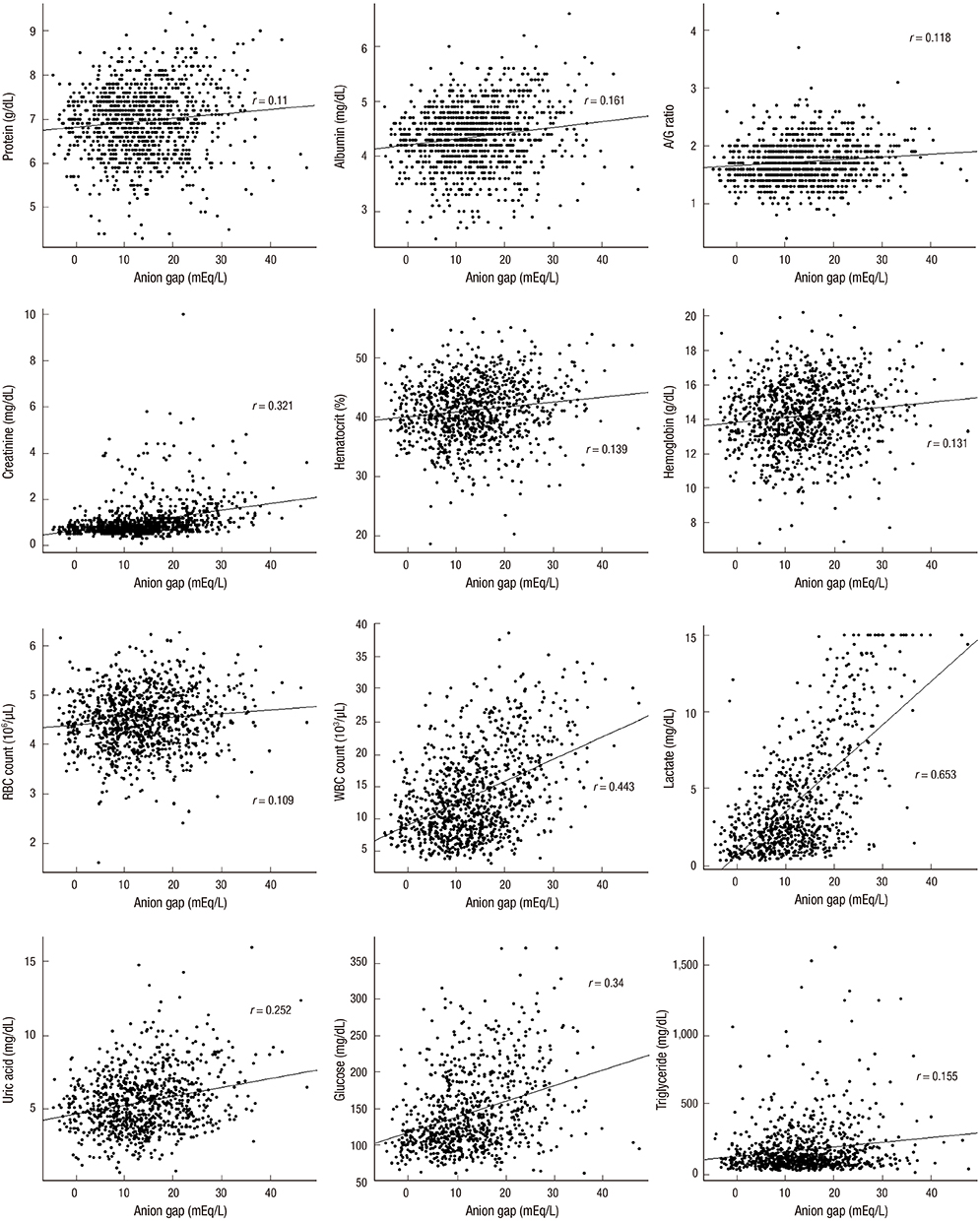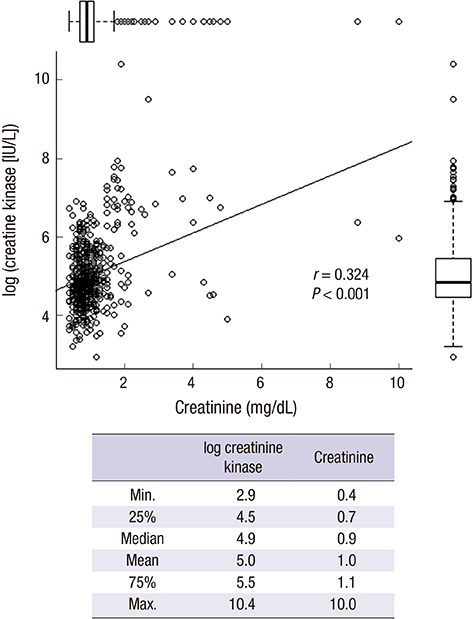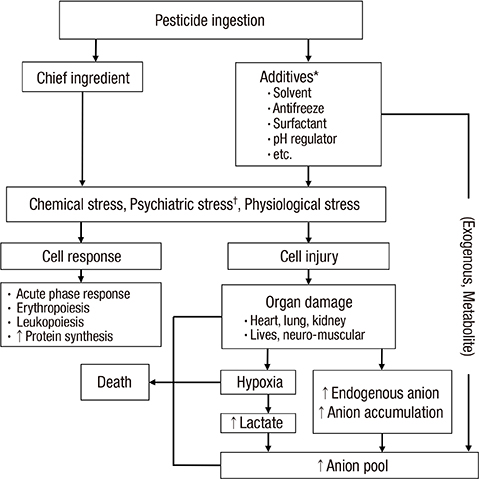J Korean Med Sci.
2016 Jul;31(7):1150-1159. 10.3346/jkms.2016.31.7.1150.
The Anion Gap is a Predictive Clinical Marker for Death in Patients with Acute Pesticide Intoxication
- Affiliations
-
- 1Department of Internal Medicine, Soonchunhyang University Cheonan Hospital, Cheonan, Korea. syhong@sch.ac.kr
- 2Department of Emergency Medicine, Soonchunhyang University Cheonan Hospital, Cheonan, Korea.
- 3Department of Biostatistics, Soonchunhyang University, College of Medicine, Seoul, Korea.
- KMID: 2373737
- DOI: http://doi.org/10.3346/jkms.2016.31.7.1150
Abstract
- Pesticide formulation includes solvents (methanol and xylene) and antifreeze (ethylene glycol) whose metabolites are anions such as formic acid, hippuric acid, and oxalate. However, the effect of the anion gap on clinical outcome in acute pesticide intoxication requires clarification. In this prospective study, we compared the anion gap and other parameters between surviving versus deceased patients with acute pesticide intoxication. The following parameters were assessed in 1,058 patients with acute pesticide intoxication: blood chemistry (blood urea nitrogen, creatinine, glucose, lactic acid, liver enzymes, albumin, globulin, and urate), urinalysis (ketone bodies), arterial blood gas analysis, electrolytes (Na+, K+, Cl- HCO3 -, Ca++), pesticide field of use, class, and ingestion amount, clinical outcome (death rate, length of hospital stay, length of intensive care unit stay, and seriousness of toxic symptoms), and the calculated anion gap. Among the 481 patients with a high anion gap, 52.2% had a blood pH in the physiologic range, 35.8% had metabolic acidosis, and 12.1% had acidemia. Age, anion gap, pesticide field of use, pesticide class, seriousness of symptoms (all P < 0.001), and time lag after ingestion (P = 0.048) were significant risk factors for death in univariate analyses. Among these, age, anion gap, and pesticide class were significant risk factors for death in a multiple logistic regression analysis (P < 0.001). In conclusions, high anion gap is a significant risk factor for death, regardless of the accompanying acid-base balance status in patients with acute pesticide intoxication.
Keyword
MeSH Terms
-
Acid-Base Equilibrium
Acidosis/etiology
Adolescent
Adult
Aged
Aged, 80 and over
Anions/*chemistry/metabolism
Biomarkers/*chemistry/metabolism
Blood Gas Analysis
Chemically-Induced Disorders/mortality/pathology
Electrolytes/analysis
Female
Humans
Intensive Care Units
Logistic Models
Male
Middle Aged
Odds Ratio
Pesticides/*poisoning
Prospective Studies
Risk Factors
Survival Analysis
Urinalysis
Young Adult
Anions
Biomarkers
Electrolytes
Pesticides
Figure
Reference
-
1. Weerasinghe M, Konradsen F, Eddleston M, Pearson M, Gunnell D, Hawton K, Jayamanne S, Pabasara C, Jayathilaka T, Dissanayaka K, et al. Risk factors associated with purchasing pesticide from shops for self-poisoning: a protocol for a population-based case-control study. BMJ Open. 2015; 5:e007822.2. Aggarwal S. Suicide in India. Br Med Bull. 2015; 114:127–134.3. Gao X, Duan L, Yang C, Ye P, Ji C, Wang Y, Deng X, Jin Y, Er Y, Wang L. Analysis on the characteristics of self-inflicted injury/suicide based on the Chinese National Injury Surveillance System from 2006 to 2013. Zhonghua Liu Xing Bing Xue Za Zhi. 2015; 36:17–19.4. Cho HD, Kim NY, Gil HW, Jeong DS, Hong SY. Comparison of families with and without a suicide prevention plan following a suicidal attempt by a family member. J Korean Med Sci. 2015; 30:974–978.5. Moon JM, Chun BJ. Predicting acute complicated glyphosate intoxication in the emergency department. Clin Toxicol (Phila). 2010; 48:718–724.6. Lee HL, Chen KW, Chi CH, Huang JJ, Tsai LM. Clinical presentations and prognostic factors of a glyphosate-surfactant herbicide intoxication: a review of 131 cases. Acad Emerg Med. 2000; 7:906–910.7. Gil HW, Jeong MH, Park JS, Choi HW, Kim SY, Hong SY. An outbreak of food borne illness due to methomyl pesticide intoxication in Korea. J Korean Med Sci. 2013; 28:1677–1681.8. Gil HW, Hong JR, Song HY, Hong SY. A case of methanol intoxication caused by methomyl pesticide ingestion. Hum Exp Toxicol. 2012; 31:1299–1302.9. Bahrami A, Jonidi-Jafari A, Mahjub H. Environmental exposure to xylenes in drivers and petrol station workers by urinary methylhippuric acid. J Res Health Sci. 2008; 8:61–68.10. Time oriented score system (TOSS): a method for direct and quantitative assessment of nursing workload for ICU patients. Italian Multicenter Group of ICU research (GIRTI). Intensive Care Med. 1991; 17:340–345.11. Del Bufalo C, Morelli A, Bassein L, Fasano L, Quarta CC, Pacilli AM, Gunella G. Severity scores in respiratory intensive care: APACHE II predicted mortality better than SAPS II. Respir Care. 1995; 40:1042–1047.12. Gil HW, Hong JR, Jang SH, Hong SY. Diagnostic and therapeutic approach for acute paraquat intoxication. J Korean Med Sci. 2014; 29:1441–1449.13. Kitterer D, Schwab M, Alscher MD, Braun N, Latus J. Drug-induced acid-base disorders. Pediatr Nephrol. 2015; 30:1407–1423.14. Emmett M. Approach to the patient with a negative anion gap. Am J Kidney Dis. 2016; 67:143–150.15. Gil HW, Yang JO, Lee EY, Hong SY. Clinical implication of urinary neutrophil gelatinase-associated lipocalin and kidney injury molecule-1 in patients with acute paraquat intoxication. Clin Toxicol (Phila). 2009; 47:870–875.16. Kim SJ, Gil HW, Yang JO, Lee EY, Hong SY. The clinical features of acute kidney injury in patients with acute paraquat intoxication. Nephrol Dial Transplant. 2009; 24:1226–1232.17. Nozuma S, Okamoto Y, Higuchi I, Yuan J, Hashiguchi A, Sakiyama Y, Yoshimura A, Higuchi Y, Takashima H. Clinical and electron microscopic findings in two patients with mitochondrial myopathy associated with rpisodic hyper-creatine kinase-emia. Intern Med. 2015; 54:3209–3214.18. Finsterer J, Stöllberger C, Kovacs GG. Asymptomatic hyper-creatine-kinase-emia as sole manifestation of inclusion body myositis. Neurol Int. 2013; 5:34–36.19. Park JS, Seo MS, Gil HW, Yang JO, Lee EY, Hong SY. Incidence, etiology, and outcomes of rhabdomyolysis in a single tertiary referral center. J Korean Med Sci. 2013; 28:1194–1199.20. Zhao JL, Baltimore D. Regulation of stress-induced hematopoiesis. Curr Opin Hematol. 2015; 22:286–292.21. González-Murillo Á, Fernández L, Baena S, Melen GJ, Sánchez R, Sánchez-Valdepeñas C, Segovia JC, Liou HC, Schmid R, Madero L, et al. The NFKB inducing kinase modulates hematopoiesis during stress. Stem Cells. 2015; 33:2825–2837.22. Zulkifli I, Najafi P, Nurfarahin AJ, Soleimani AF, Kumari S, Aryani AA, O’Reilly EL, Eckersall PD. Acute phase proteins, interleukin 6, and heat shock protein 70 in broiler chickens administered with corticosterone. Poult Sci. 2014; 93:3112–3118.23. Argente MJ, García ML, Birlanga V, Muelas R. Relationship between cortisol and acute phase protein concentrations in female rabbits. Vet J. 2014; 202:172–175.24. Kraut JA, Nagami GT. The serum anion gap in the evaluation of acid-base disorders: what are its limitations and can its effectiveness be improved? Clin J Am Soc Nephrol. 2013; 8:2018–2024.25. Lee JW, Hwang IW, Kim JW, Moon HJ, Kim KH, Park S, Gil HW, Hong SY. Common pesticides used in suicide attempts following the 2012 paraquat ban in Korea. J Korean Med Sci. 2015; 30:1517–1521.
- Full Text Links
- Actions
-
Cited
- CITED
-
- Close
- Share
- Similar articles
-
- The Metabolic Acidosis and Clinical Outcome in Acute Infantile Diarrhea
- Clinical Usefulness of the Serum Anion Gap
- A Case of Salicylate-Intoxication-Induced Pseudohyperchloremia
- Incidence, Etiology, and Outcomes of Rhabdomyolysis in a Single Tertiary Referral Center
- Risk Factors to Predict Acute Respiratory Failure in Patients with Acute Pesticide Poisoning







